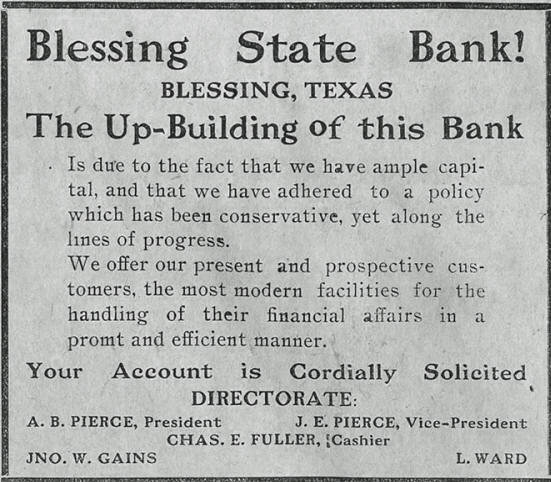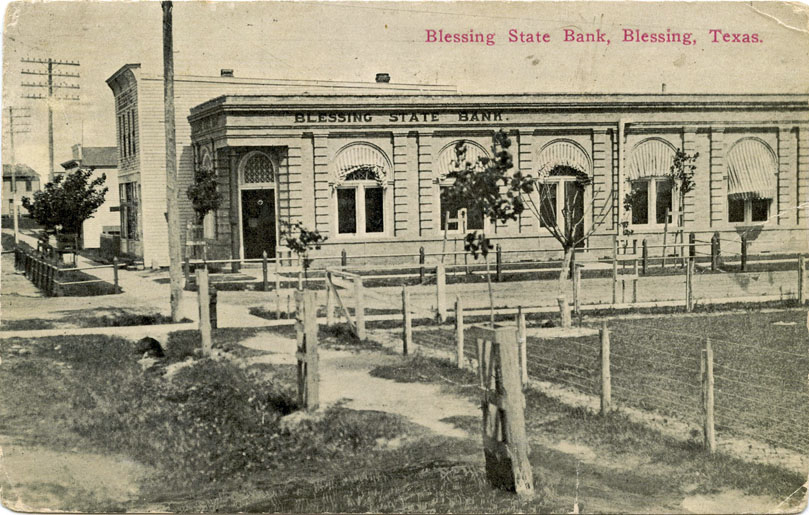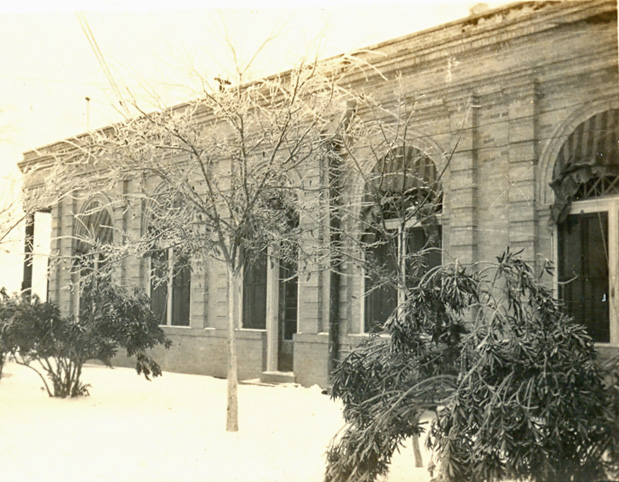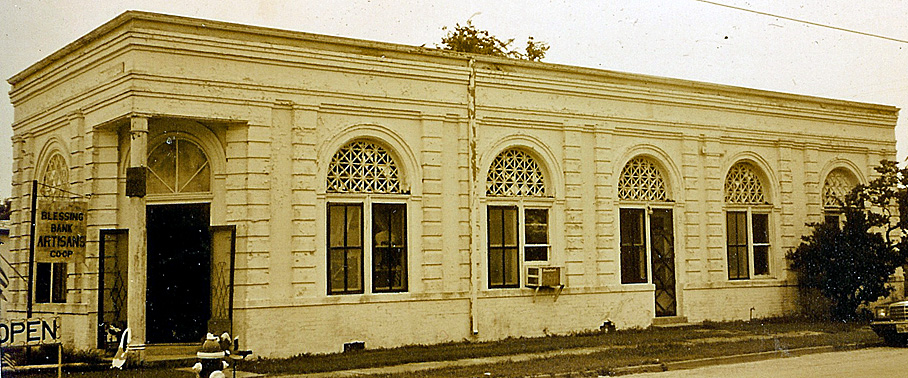BLESSING STATE BANK
Written
by Mary Belle Ingram
Blessing, Texas, a small town situated in the western part of
Matagorda County was formerly part of the vast holdings of Jonathan
Edwards Pierce and his brother Abel Head "Shanghai" Pierce
who had acquired the land after the War between the States. The area
was mostly ranch land and did not really see economic growth until the
Galveston-Harrisburg and
San Antonio
. (G.H. &
S.A.
) railroad reached
there in 1903. Jonathan E. Pierce had given the railroad a right of
way through his ranch.
When the railroad was pushing southward at the turn of the
century, it followed the custom of granting each landowner who had
offered rights of way the privilege of naming the post office
established on his land. Jonathan was granted that privilege. When the
delegation of railroad officials asked if he had picked a name for the
station, the story is told that Pierce answered firmly, "I sure
have. THANK GOD!" The official convinced him that name would
never do and told him it was a blessing that the railroad was right
there on his ranch, a blessing to the whole region, and a blessing
that a man of Pierce's perception had lain in wait for the rails.
Pierce gradually became convinced and so named the new town
"Blessing."
Jonathan Edwards Pierce was born in Little Compton, Rhode
Island, on
December 6, 1839
, and joined his
brother, Abel, in 1858 to work on the ranch of W. B. Grimes near the
present town of
Blessing
. He became a rancher
and cattleman with large holdings. On
May 2, 1867
, Pierce married
Nannie Deborah Lacy who was born
August 11, 1845
, and they built
their home, "Rancho Grande," on the
Tres
Palacios
River
. Four children were
born to Jonathan Edwards and Nannie Deborah Lacy Pierce at
"Rancho Grande:" John Phillips, Abel Brown,
Pearl
and Grace Harriett.
Nannie Lacy Pierce died in 1896. Jonathan Edwards married second Grace
Lawrence and their children were James Lawrence and Evelyn. After
Grace's death, he married Laura Duffield and they had a son, Jonathan
E. Jr. Jonathan Edwards died in 1915 in
Galveston
and is buried in
Hawley
Cemetery
. Abel B., the second
son of Jonathan Edwards and Nannie Lacy Pierce was born
December 4, 1874
, at "Rancho
Grande" and married Adelaide Hall
January 19, 1909
, in
St. Paul
,
Minnesota
.
Adelaide
, born in 1885, came
to live in Blessing for the remainder of her life until her death in
1967. Abel B. Pierce died in 1944. Abel Brown Pierce, Sr., and his
wife,
Adelaide
, were active in the
early life of Blessing,
Texas
, and were
instrumental in the establishment of the Blessing State Bank.
Adelaide
was a historian and
due to her writings and knowing the value of preserving records, the
early history of Blessing has been preserved. Many of her articles
have been placed in the archival holdings of the
Matagorda
County
Museum
.
"Rancho Grande" at Deming's Bridge community was
the site of the Pierce ranching headquarters with many buildings,
including a store, an office building, etc., on the site. With the
beginning of the new town of Blessing, between 1903 and 1905, Jonathan
moved his small business office which was used by the ranch bookkeeper
to the new town. This small building housed the new town's banking
operations until the 1907 building was erected. Other buildings moved
to the new town were the Masonic Lodge Hall and the old
Moore
store building. The
Moore
store became the
site of the first post office in Blessing.
 By 1904 a second railroad line, the
St. Louis
,
Brownsville
, and
Mexico
had pushed its way
through the Blessing area. That line is still in existence and today
(1996) is known as the Union Pacific. In 1905 the magnificent and
imposing "Rancho Grande" home burned, and by 1907 Colonel J.
E. Pierce had begun construction of the Hotel Blessing on Block 35
facing
10th Street
. By 1904 a second railroad line, the
St. Louis
,
Brownsville
, and
Mexico
had pushed its way
through the Blessing area. That line is still in existence and today
(1996) is known as the Union Pacific. In 1905 the magnificent and
imposing "Rancho Grande" home burned, and by 1907 Colonel J.
E. Pierce had begun construction of the Hotel Blessing on Block 35
facing
10th Street
.
The first plat of the Blessing townsite was made by J. A.
Donaldson on
May 17, 1907
. On
September 1, 1907
, the Blessing
Townsite was surveyed and stakes were driven marking the streets and
alleys. Provisions were made for a school and churches and a block
called "The Common" was set aside as required. Across the
street from the "Common," at the corner of Avenue B and
10th Street
on Block 22, plans
for construction of the Blessing State Bank were underway. To the west
across the street was "Hotel Blessing" which is now on the
National Register of Historic Places.
With two major railways coming through the new town, land
speculators from the north promoted the area as a place where
"happy farmers are picking strawberries every day" prompting
people from the cold north winters to come flocking into Texas with
many settling in the Blessing area. The Burton D. Hurd Land Company
set up an office in Blessing to promote the sale of lots. By early
1907 there were six buildings in Blessing, the Jesse Laramore Store,
the D. A. Wheeler Hotel, the A. B. Pierce office which also served as
a bank, and the two railroad stations. All the land around was a
waving field of prairie grass.
The remainder of 1907 witnessed a construction boom.
According to an invitation to the public, the Blessing State Bank
announced that "it would open as a Bank of Deposit and Discount
at Blessing,
Texas
October 1, Nineteen
Hundred and Seven." On the announcement a list of the directors
was noted: A. B. Pierce, Joe Pybus, John W. Gaines and Jesse Laramore.
In the deed records of the Matagorda County Courthouse a document
#21410 filed for record
September 23, 1907
, read in part:
Know all men by these presents, That we, A. B. Pierce,
John W. Gaines, H. B. Farwell, John M. Corbett and Jos. Pybus, have
and do hereby associate ourselves together by articles of agreement in
writing, as provided by law, for the purpose of establishing a bank to
be incorporated under the laws of the State of Texas, for the object
and purposes and in the manner hereinafter set forth.
The
name of this Corporation shall be the Blessing State Bank. The amount
of capital stock is hereby fixed at Ten Thousand ($10,000).

Corbett and Gaines were prominent lawyers and citizens of
Bay City
, the county seat of
Matagorda
County
; Pybus and Farwell
were prominent citizens of Palacios. Farwell had come to the region
from
Minnesota
and was a friend of
the Pierces. Abel B. Pierce, Sr., was the son of Jonathan E. Pierce.
The application was approved by Secretary of State L. T. Dashiell and
Charter #18363-0 was issued.
A January 1909 Blessing newspaper listed the "Blessing
State Bank built in 1907, capital stock $10,000, J. E. Pierce,
President; J. A. Williams, Cashier; Directors: J. E. Pierce, J. W.
Gaines, H. P. Farwell, Jos. Pybus, Sr., and C. H. Crandall.
The
November 26, 1909
, Blessing paper
reported the Blessing Bank with resources of $83,753.48 with A. B.
Pierce as President, J. E. Pierce, Vice President; J. A. Williams,
Cashier; and J. B. Leaman, Director.
Blessing State Bank served this rural agricultural community
until it was closed in February 1932 as the Great Depression affected
the entire country. The bank closed with a capital stock of $25,000
and no loss to its depositors. Operations were then taken over by the
Palacios State Bank. One of the reasons given for the bank failure was
that of a $20,000 rice loan with old farm machinery as collateral to
Kiyaki Saibara, a Japanese-American. Saibara used the money to buy
land near
Galveston
and left the bank
with the rusted machinery.
From 1932 until 1995 the Blessing State Bank building served
as an office for Lee M. Pierce and his Ace of Clubs Ranch. It also
served as a post office and fine arts workshop. Through the years the
architecture of the building remained the same, and most of the
original fixtures and furnishings remained in the building.
 During the time the bank building was under construction in
1907, the Blessing Hotel was erected. The renown architect Jules
Leffland of
Victoria
designed the hotel
building as well as the Blessing Bank. Two banks built in
Bay City
in 1903 with Jules
Leffland as the architect have a similarity in style with the Blessing
Bank. During the time the bank building was under construction in
1907, the Blessing Hotel was erected. The renown architect Jules
Leffland of
Victoria
designed the hotel
building as well as the Blessing Bank. Two banks built in
Bay City
in 1903 with Jules
Leffland as the architect have a similarity in style with the Blessing
Bank.
The First State Bank of Louise purchased the building in 1996
and bought the adjoining lot for parking. In June of 1996 restoration
of both the interior and exterior was begun to restore the building to
its original early 20th century grandeur. William R. Jenkins, III,
Assistant Vice President of the First State Bank of Louise at the time
and now (1997) in charge of the Blessing Bank, was the driving force
in the restoration. The new name for the historic bank became
"First State Bank - Blessing Branch." Jenkins consulted the
state for assistance and completed an application to the National
Register of Historic Places for recognition of this building. The
following quoted from the National Register application submitted in
regard to the physical appearance of the building:
Building
with a potential listing in the National Register in Criterion C, an
early 20th Century bank building. This one story, flat roofed,
unpainted, yellow brick building was built in 1906. (Note: records
indicate it was begun in 1907.) The bank is rectangular in shape and
features nine feet tall regularly spaced arched windows along the west
side of the building, and one window on the north side. There are three
doors on the building, one at the main entrance (northwest side),
another built into the third arched window on the west side, and the
last door in the rear of the building (south end). The east side of the
building has no windows or doors because it was once up against an
adjacent building. The interior of the building is separated into three
rooms.
The
front of the building was the original bank area while the back of the
building was mostly used for storage and office space. The front room
features an antique teller line with steel bars, marble slate, and
etched glass. Also in the teller area there is a large antique vault
which inside features an early 20th Century money vault. The front room
has been modernized with a drop ceiling and a ceramic tile floor, but
other wise most of the material in the bank is in its original form. Mr.
Lee M. Pierce, the son of one of the men, (A. B. Pierce, Sr.) that
helped to start the bank, made these changes when he used the building
for his personal office. The back room was an addition to the original
bank, built between 1907 and 1912. The addition has the same type brick,
architecture, and windows as the original building. The original bank
and the addition are separated by a large brick wall with only one door
opening. The addition features another 20th Century vault which holds
the original safety deposit boxes. The bank's walls in all rooms have
painted stucco with some spots of deterioration revealing the original
brick. There is other historical fabric in the building, such as,
antique furniture, original wainscoting on some walls, and all solid
wooden doors.

Blessing Bank Artisans Coop - 1992
First
State
Bank - Blessing
Branch, a branch of the First State Bank of
Louise
,
Texas
, was completed and had
its formal opening
January 29, 1997
. The restored building
has retained many of its original features from the mosaic tile floors
to the pressed tin ceilings. The windows feature mahogany frames,
attractive lattice work and tasteful awnings. The original teller lines
and much of the antique furniture are now part of the new but old bank -
now called FIRST STATE BANK - BLESSING BRANCH and once again meets the
needs of a rural agricultural community.
|